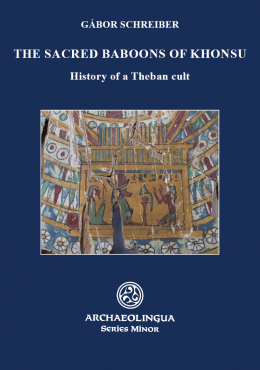The Sacred Baboons of Khonsu

The Sacred Baboons of Khonsu
| 9 590 Ft |
| Price |
Series Minor No. 44
Budapest, Archaeolingua, 2020
Puhakötés | Paper book, 23.5 × 16.5 cm
175 oldal, színes és fekete-fehér illusztrációkkal | 175 pages with colored and grayscale images
ISBN 978 615 5766 35 0
ISSN 12 166 847
This book is also available in Hungarian | Ez a könyv magyarul is elérhető.
The short period of the last indigenous kings of the 30th dynasty (380–343 BC) meant the beginning of a late renaissance of pharaonic culture and religion all throughout the country, including the Upper Egyptian sacred city, Thebes. Great new building projects, comparable in scale with earlier enterprises of the times when Egypt reigned supreme, were initiated in the sacred precincts of Thebes, whose monumental legacy, still visible today, served as a guideline for later temple building programmes, and determined the structure and framework of the Theban sacred landscape for the last centuries of the ancient religion.
This book is about the history and Theban role of a small, virtually unknown cult. At the centre of this cult stood the Living Baboon, a special zoomorphic avatar of the youthful god of the Theban triad, Khonsu, and the sacred apes that were the earthly incarnations of the god. It is thus one of the animal cults that became ever more popular from the Late Period onwards, exerting a significant influence on Egyptian religious practice.
The South Khokha Project of the Theban expedition of Eötvös Loránd University has been excavating the Theban rock-cut tomb -400- since 2007. In the tomb which was originally built in the New Kingdom and remained in use until the Roman Period, the expedition unearthed in 2015 and 2016 a secondary shaft tomb with the finds of a group burial dated to the Ptolemaic Period. Part of this group burial belongs to one family, the so-called Teos family, and at least two of its male members, the great man of the family, Teos, and his son, Petenephotes, were in the service of the cult in the early Ptolemaic Period. Their burial goods, which are also extremely interesting from an art historical perspective, display a series of official titles that include hitherto unknown designations, allowing us to gain an insight into the activities of the cult personnel.
| |
|
|
1067 Budapest, Teréz krt. 13. |
|
|
|
|
About us
The Archaeolingua Foundation and Publisher is involved in publishing series and standalone publications in the disciplines of archaeology, linguistics, historic sciences and heritage protection for over 25 years.
Learn more
Publishing
We publish both as standalone editions and as a volume of a professional series.
Learn more
Contact us
Archaeolingua Foundation

